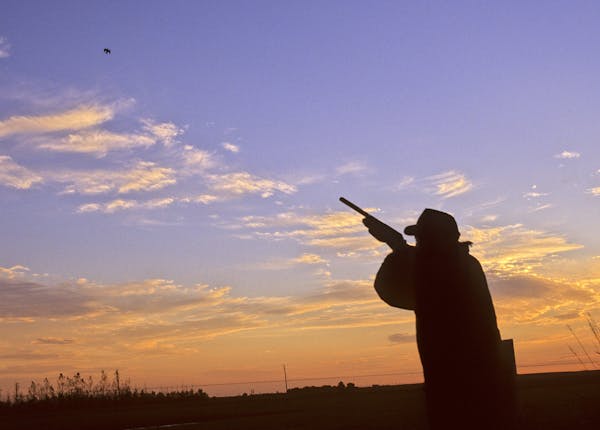5 A.M. THURSDAY, MORRISON COUNTY — One back road led to another and another, the outlines of tall corn and mowed alfalfa illuminated alternately by our headlights. Up ahead were Bill Marchel and Rolf Moen, the taillights of Bill's van obscured in the still-dark of early morning and by the dust plume that separated his vehicle and mine. I had a shotgun riding shotgun, a 20-gauge, a vintage two-piper, while on the radio Steve Winwood crooned Gimme some lovin', his keyboards flawless. A good morning so far. This was Sept. 1, the first day of the state's latest rendition of dove hunting, and not in a known hotspot. Minnesota raises millions of mourning doves each summer, or thereabouts, but sends most south beginning in August, before the season opener. This excites thankful Kansas, Oklahoma and Texas hunters, among those in other states, who on most early autumn days can barely lock and load fast enough so many doves are in the air. By contrast Minnesota scattergunners often peer into skies largely devoid of mourning doves, North America's most popular game bird.
Yet, in places, bright spots exist for northern-clime dove hunters. Certainly the Dakotas with their vast acreages of small grains and sunflowers and potholes provide ideal dove habitat, and the hunter there who possesses a 5-gallon bucket to plop onto and a box or two of chilled steel can enjoy a relaxing morning, evening or both, targeting the darting birds as they trade from food to drink, the dove hunter taking shots — pop, pop — hitting some and, as always with doves, missing many.
Similarly, Minnesota farmlands can at times offer classic dove hunting. Not in the endless fields of corn or soybeans that blanket the landscape. But alongside or in cut expanses of wheat, barley or oats. Break-even cash crops, or worse, that these might be for farmers, they are nonetheless highly valued by ground-feeding birds such as doves.
Thursday morning in Morrison County, generally between St. Cloud and Brainerd, where for generations growers have plowed sandy loam, Bill, Rolf and I would attempt to divine where exactly the region's doves were concentrated, "concentrated'' being used loosely here, and intercept them on their morning flights.
"Remember this place?'' Bill asked.
We had pulled alongside a minimally maintained road and parked. Quickly Rolf freed Sally, his young German shorthair, from Bill's vehicle and as quickly the dog bounded in and among the surrounding hinterlands, her movements occasionally silhouetted against the sliver of crimson and midnight blue that presaged the sun's ascension in the eastern sky.
"I do,'' I said.
At this same location, or nearly so, Bill, Rolf and I had begun dove season a few years back. Birds flew that morning with abandon, as if Hitchcock himself were directing, and in response our shotguns breathed fire into the cool morning. Infused with jalapenos, seasoned delicately and lightly grilled, a dinner of dove breasts was soon gathered.
Now another outing was upon us, and amid the morning's gathering light Bill, Rolf and I, accompanied by Sally the German shorthair, positioned ourselves helter-skelter in and adjoining the border of a state wildlife management area. Nearby an alfalfa field lay neatly cut, while in another direction, as far as we could see, stood corn, corn and more corn. Bordering these were the odd stands of foxtail and Johnson grass, whose seeds are dove favorites.
Legal shooting time arrived a few minutes after 6, and as if on cue, just then, one dove, then another flew nearby. "Erratic'' describes the flights of these birds. Ditto "drunken.'' Rising and falling in altitude almost simultaneously, while banking left or right, or left and right, doves in flight are targets made to be missed — one reason nationally that more ammo is spent trying to hit these gamey little critters than is expended on any other winged species. Or perhaps all of them together.
Soon one bird was in hand, falling to Bill's gun. Then Rolf drew down on a high specimen that painted a broad arch against the cool morning sky as it catapulted to the ground, soon to be retrieved by Sally for delivery to her master's hand. Action wasn't continual. But enough birds were in the air to keep us on the lookout, our eyes peeled and our heads pivoting as if on gimbals.
We heard no other shots. Only ours. And saw no other hunters.
With a clear sky and gentle breeze, morning broke beautifully. Somewhere perhaps not far away someone vectored toward an office cubicle, or turned the key of a big green tractor.
Spared for the time being these obligations and others, we watched the sky, and for the better part of an hour doves flew, a small percentage of which fell to our guns.
Then the day warmed, action cooled, and what birds there were settled contentedly into their morning feeding grounds and could be seen no more.
"Remember this place?'' Bill had asked.
I had. And I will.
Analysis: Golf has two dominant forces in Scheffler and Korda. It didn't happen overnight
Mark Craig's first-round mock draft: How will Vikings grab a QB?
Havertz scores 2 as Arsenal routs Chelsea 5-0 to cement Premier League lead

Caitlin Clark is set to sign a new Nike deal valued at $28 million over 8 years, reports say

